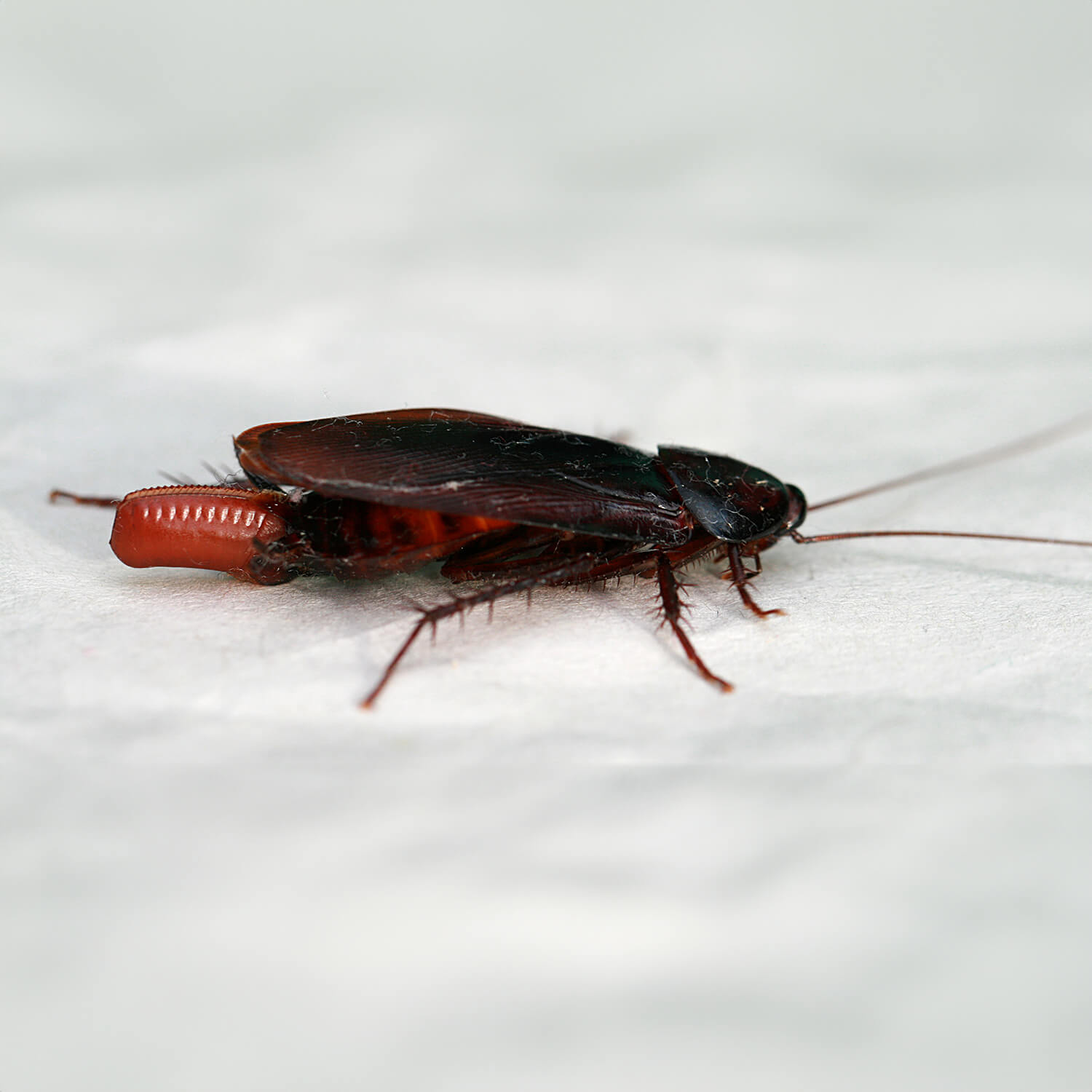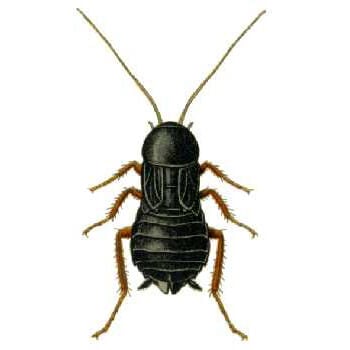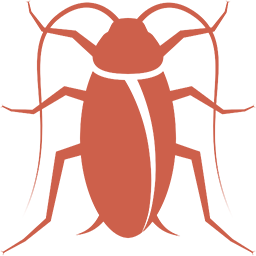Cockroach Control Guide: Effective Removal Tips
Cockroaches are remarkable insects that have adapted and thrived on Earth for millions of years. These resilient creatures are typically brown or black, possess a flat, oval-shaped body, and come in various sizes depending on the species. With a global presence, cockroaches inhabit a wide range of environments, favoring warm and humid conditions. Their nocturnal behavior makes them experts at hiding during the day and emerging at night to scavenge for food. Understanding the general characteristics and behaviors of cockroaches is crucial for effective pest management strategies.
The different species of cockroach
The most common species of cockroaches that are often encountered in human environments include:

German Cockroach (Blattella germanica)
The German cockroach is a small, light brown to tan insect, measuring around 1/2 to 5/8 inch in length. It is a common household pest, often infesting kitchens, bathrooms, and other warm, humid areas. These cockroaches are notorious for their rapid reproduction rates, making them a challenging nuisance to eliminate

Brown-Banded Cockroach (Supella longipalpa)
The brown-banded cockroach is smaller, typically measuring around 1/2 inch in length. It has a light brown color with distinct pale bands across its body. This species favors dry, warm locations, often hiding in bedrooms, living rooms, furniture, and behind picture frames.

American Cockroach (Periplaneta americana)
The American cockroach is one of the largest cockroach species, reaching lengths of up to 2 inches. It is reddish-brown and thrives in damp, dark environments such as basements and sewers. Often referred to as “palmetto bugs” or “waterbugs,” they are known for their resilience and adaptability to various habitats.

Smokybrown Cockroach (Periplaneta fuliginosa)
Dark brown to black in color, the smokybrown cockroach averages about 1.5 inches in length. It thrives in warm, humid conditions and is commonly found outdoors in wooded areas. However, it may venture into homes. This species is known for its distinctive smoky appearance and can be a nuisance in some regions.

Oriental Cockroach (Blatta orientalis)
Shiny black or dark brown, the Oriental cockroach grows to about 1 inch in length. These cockroaches prefer cool, damp areas like crawl spaces and drains. They are sometimes called “waterbugs” due to their habitat preferences and are a common sight in areas with high humidity.
These are some of the most common cockroach species found in human environments, each with its own preferences in terms of habitat and behavior. Effective pest control strategies may vary depending on the specific species present.
Cockroaches are incredibly ancient insects, with a history dating back over 300 million years. They are believed to have evolved during the Carboniferous period.
The life cycle of cockroach
To effectively manage and control cockroach infestations, it’s essential to comprehend their life cycle. Cockroaches undergo a series of distinct stages in their development, each contributing to their remarkable resilience.

Egg Stage
The cockroach life cycle begins with the egg stage. Female cockroaches lay egg cases, known as oothecae, in hidden and protected areas. Each ootheca can contain multiple eggs and acts as a shield, safeguarding the eggs from potential threats.

Pupal Stage
Following several molts, nymphs undergo metamorphosis into adult cockroaches. Adult cockroaches possess fully developed wings (if their species is winged) and are capable of mating and reproducing. Throughout their adult lives, they periodically molt to renew their exoskeletons and support their growth.

Nymph Stage
After hatching, cockroach nymphs emerge. These juvenile insects resemble miniature versions of adult cockroaches but lack wings and start off pale or white in color. They undergo multiple molting stages, shedding their exoskeletons as they grow and mature.

Reproduction and Lifespan
Adult cockroaches engage in mating, and females subsequently produce oothecae or egg cases. The lifespan of a cockroach varies by species but generally ranges from several months to a few years. Cockroaches are notorious for their ability to reproduce rapidly, with a single female capable of producing numerous offspring during her lifetime. This prolific breeding can lead to infestations if not effectively controlled.
Understanding the cockroach life cycle empowers effective pest control strategies, enabling individuals to disrupt their reproductive cycle and minimize their presence in homes and businesses.
Cockroaches are renowned for their resilience and ability to survive in harsh conditions. They can endure extreme temperatures, high levels of radiation, and even survive without food for extended periods.
The seasons most conducive to cockroach
Cockroaches are hardy creatures that can adapt to various environments, but there are certain seasons when they thrive more than others. Understanding these seasonal preferences can help you take proactive measures to keep your home or business cockroach-free.

Spring
As temperatures begin to rise in the spring, cockroaches become more active. The warmth and increased moisture levels create ideal conditions for their reproduction. Cockroaches seek shelter indoors during this time, making it crucial to seal any cracks or openings in your home to prevent their entry.

Fall
As the weather cools in the fall, cockroaches start looking for warmth and shelter. Your cozy home becomes an attractive haven for them. Inspect your property for any gaps in doors or windows, and keep your space well-ventilated to reduce humidity levels.
Summer
Summer is the peak season for cockroach activity. The combination of heat and humidity is perfect for these pests. They tend to infest kitchens and bathrooms where moisture levels are higher, and food sources are plentiful. Regular cleaning and maintenance are essential to deter them.
Winter
While cockroaches are less active during winter, they don’t disappear entirely. They’ll hide in warm, secluded spots within your home, such as behind appliances or inside wall voids. Insulation and weatherproofing can help keep them at bay.
It’s important to note that cockroaches are a year-round concern, but their activity levels and behaviors vary with the seasons. To prevent infestations, maintain a clean living environment, eliminate food sources, and seal entry points throughout the year. Regular pest control inspections can also help ensure your home remains cockroach-free, regardless of the season.
Cockroaches can live for a short time without their heads. This is because they breathe through small openings on their bodies called spiracles, not their
Where do cockroach come from, their habitat
Cockroaches are highly adaptable insects with a wide range of habitats, making them a common nuisance in many parts of the world. Understanding where they come from and their preferred habitats can help you take effective measures to control and prevent infestations.

Natural Habitats
Cockroaches have been around for millions of years and are believed to have originated in tropical and subtropical regions. They are often found in forested areas, where they play a vital role in breaking down decaying plant matter. In these natural habitats, they seek shelter under leaves, fallen logs, and in the soil.

Indoor Hideouts
Within buildings, cockroaches prefer dark, warm, and humid spaces. Common hiding spots include cracks and crevices in walls, under appliances, behind kitchen cabinets, and in basements or crawl spaces. They are attracted to areas with food residue, moisture, and warmth.
Nocturnal Creatures
Cockroaches are primarily nocturnal, meaning they are most active at night. They use darkness as cover to forage for food and mate. This behavior can make them challenging to spot during the day.

Urban Dwellers
Cockroaches have successfully adapted to urban environments. They thrive in places with easy access to food, water, and shelter. In cities, they can be found in a variety of locations, including homes, restaurants, grocery stores, and sewers.

Moisture-Seekers
Cockroaches are particularly drawn to areas with high humidity levels. Bathrooms, kitchens, and laundry rooms are prime locations because of the presence of water sources. Fixing leaks and maintaining dry conditions can help deter them.

Transport via Goods
Cockroaches can also be introduced to new locations through the transportation of goods. They may hitch a ride in boxes, bags, or shipments, which is why they can quickly infest new areas.
To prevent cockroach infestations, it’s crucial to maintain cleanliness, seal entry points, eliminate food and water sources, and consider regular pest control measures, especially in areas prone to cockroach activity. By understanding their habitats and behaviors, you can better protect your home or business from these resilient pests.
Most cockroach species are nocturnal, meaning they are active at night. They prefer to forage in the dark when they are less likely to encounter predators.
What attracts cockroach into our homes
Cockroaches are attracted to homes by various factors, and understanding what lures them in can help you take preventive measures to keep these pests at bay. Here are some of the key factors that attract cockroaches into our homes:
Food Sources
Cockroaches are scavengers and are attracted to any available food. They feed on a wide range of items, including crumbs, grease, sugary substances, and even pet food. Leaving food out in the open or neglecting to clean up spills and crumbs can make your home more appealing to them.
Darkness and Nocturnal Activity
Cockroaches are nocturnal creatures, preferring to come out at night when it’s dark and quiet. They are less likely to be active in well-lit areas. Turning on lights in the kitchen and other potential hiding spots can discourage their activity.
Previous Infestations
If your home has experienced a cockroach infestation in the past, it’s more likely to attract them again. Properly addressing and eliminating the previous infestation and implementing preventive measures are essential to keep them from returning.
Water and Moisture
Cockroaches need water to survive, and they are drawn to areas with high humidity levels. Leaky pipes, dripping faucets, and standing water can provide a water source for cockroaches. Fixing leaks and ensuring proper drainage can help reduce their attraction.
Dirty and Unsanitary Conditions
Poor sanitation practices can create ideal conditions for cockroach infestations. Accumulated garbage, dirty dishes, and inadequate cleaning can provide both food and shelter for these pests. Maintaining cleanliness and practicing good hygiene can deter them.
External Factors
Sometimes, cockroaches are attracted to your home from the outside. They can enter through gaps in doors and windows or through utility openings. Installing screens, weatherstripping, and sealing potential entry points can help prevent their access.
Warmth and Shelter
Cockroaches seek out warm and sheltered environments. Cracks in walls, gaps in doors and windows, and cluttered areas can serve as hiding spots for these pests. Properly sealing entry points and reducing clutter can make your home less inviting.
Leftover Odors
Cockroaches can detect the scent of food even when it’s not visible. Lingering food odors on dishes or in trash cans can attract them. Properly sealing food containers and taking out the trash regularly can help eliminate these odors.
By addressing these factors and implementing proactive pest control measures, you can reduce the attractiveness of your home to cockroaches and decrease the likelihood of infestations.
Cockroaches are opportunistic feeders and will eat almost anything, including food scraps, cardboard, glue, and even each other in some cases.
Signs that you have a cockroach’ infestation
Recognizing the signs of a cockroach infestation early is crucial for effective pest control. Cockroaches are nocturnal creatures that tend to hide during the day, so you may not always spot them directly. However, several telltale signs can indicate the presence of a cockroach infestation in your home or business:
Visible Cockroaches
The most obvious sign is actually seeing live cockroaches scuttling around, especially in kitchens, bathrooms, or other areas with food and moisture. They are typically active at night, so you might notice them when turning on the lights.
Musty Odor
Cockroaches emit a musty, oily odor that can become noticeable in larger infestations. The smell may be more apparent in confined spaces, like closets or cabinets.
Smear Marks
Cockroaches leave smear marks on surfaces as they travel along walls and other objects. These marks result from their bodies picking up dirt and oils, which they then transfer onto surfaces.
Allergic Reactions
Some people may experience allergic reactions or asthma symptoms due to cockroach allergens. If residents or occupants experience unexplained respiratory issues, it could be linked to a cockroach infestation.
Droppings
Cockroach droppings are small, dark, and cylindrical in shape. They resemble coffee grounds or black pepper. You may find these droppings in areas where cockroaches are active, such as kitchen cabinets, drawers, or along baseboards.
Shed Skins
As cockroaches grow, they shed their exoskeletons. You may find these cast-off skins near their hiding spots. They are translucent and often found in areas where cockroaches molt.
Nocturnal Sounds
In some cases, you may hear rustling or scurrying noises at night. This can be an indication of cockroach activity, particularly if the infestation is significant.
Egg Cases
Cockroach egg cases, called oothecae, are purse-shaped and brownish in color. They can be found in hidden cracks, crevices, or corners. Each ootheca can contain multiple eggs.
Damaged Items
Cockroaches are known to feed on a wide range of materials, including paper, cardboard, and fabrics. If you notice damaged or chewed-up items, it could be a sign of their presence.
Feces and Urine Stains
Besides droppings, you might find urine stains as well. These stains are often visible under ultraviolet (UV) light and can indicate areas of heavy cockroach activity.
If you suspect a cockroach infestation based on these signs, it’s crucial to take action promptly. Contact a pest control professional to assess the situation, identify the type of cockroach species involved, and develop a customized treatment plan to eliminate the infestation and prevent future occurrences.
Cockroaches can be a source of allergens, as their saliva, feces, and shed skin contain proteins that can trigger allergic reactions in some individuals.
Rooms where cockroach hide
Cockroaches are notorious for their ability to hide in various locations within homes and buildings. Knowing where they tend to hide can help you target your pest control efforts more effectively. Here are common rooms and hiding spots where cockroaches are often found:

Kitchen
In the kitchen, cockroaches frequently seek refuge in cabinets, drawers, and appliances. They can also access this area through gaps around pipes and drains, making it crucial to maintain good plumbing practices.
Bedroom
Cluttered closets, bedside tables, and even beneath or within clothing piles can be hiding spots for cockroaches in the bedroom. Maintaining a clean and organized bedroom is important.
Garage
Be cautious when storing items in cardboard boxes in the garage, as cockroaches can hide within them. Cracks and gaps in the garage should be sealed to prevent entry.
Bathroom
Cockroaches may hide beneath bathroom sinks and within cabinets or medicine cabinets, particularly if moisture issues are present. Keeping your bathroom dry is essential to deter them.
Basement and Crawl Spaces
In basements and crawl spaces, cockroaches favor dark corners, cracks, and gaps. They can also hide among stored belongings. Proper sealing and organization can help reduce their presence.
Utility Areas
Water heaters, furnaces, and utility closets can provide warmth and hiding places for cockroaches. Ensuring these areas are sealed and regularly inspected is important.
Living Room
Cockroaches can hide within furniture, electronics, and cable clutter in the living room. Regular cleaning and decluttering can help prevent infestations in this space.
Laundry Room
Cockroaches may seek warmth behind laundry appliances and hide among cleaning supplies. Regular cleaning and keeping the area dry can deter them.
Dining Room
Cockroaches can hide in and under dining room furniture, especially if food crumbs are present. Built-in cabinetry can also provide hiding spots if not cleaned regularly.
To effectively address a cockroach infestation, it’s important to inspect and treat these hiding spots, focusing on areas with signs of activity. Implementing preventive measures such as sealing cracks, eliminating food sources, and reducing moisture can help deter cockroaches from taking up residence in your home.
Cockroaches reproduce quickly, with some species capable of producing thousands of offspring in a year. Their reproductive rates make them challenging pests to control.
The dangers and damages that cockroach can cause
Cockroaches are more than just a nuisance; they can pose significant dangers and cause various types of damage to both homes and human health. Understanding these risks is essential for taking prompt action to control and prevent cockroach infestations. Here are some of the dangers and damages that cockroaches can cause:
Health Risks
- Allergies and Asthma: Cockroaches produce allergens that can trigger allergic reactions, including asthma symptoms and skin rashes, in susceptible individuals.
- Disease Transmission: Cockroaches are known to carry and transmit diseases such as salmonella, E. coli, and parasitic worms. They can contaminate food and surfaces with pathogens through their droppings, urine, and body parts.
Property Damage
- Chewing and Nibbling: Cockroaches may nibble on a wide range of materials, including paper, cardboard, fabrics, and even electrical wiring. This can lead to damage to personal belongings, books, and electrical systems.
- Stains and Odors: Cockroach feces and secretions can leave unsightly stains on walls, ceilings, and surfaces. Their presence can also contribute to musty odors in infested areas.
Psychological Distress
- Anxiety and Stress: A cockroach infestation can cause significant psychological distress for residents, leading to anxiety, stress, and a reduced quality of life.
Reputation and Social Impacts
- Stigma: The presence of cockroaches can carry a social stigma, affecting your reputation and potentially causing embarrassment when hosting guests or visitors.
Food Contamination
- Bacterial Contamination: Cockroaches are attracted to food sources and can crawl over food items, leaving behind bacteria from their bodies and waste. This contamination can lead to foodborne illnesses if consumed.
- Damage to Packaging: Cockroaches can chew through packaging materials, contaminating the contents and rendering food inedible.
Allergic Reactions
- Skin Irritation: Some individuals may develop skin rashes or irritation upon contact with cockroach allergens, particularly in areas where the pests have been active.
- Respiratory Issues: Inhaling cockroach allergens can trigger asthma attacks and other respiratory problems in individuals with allergies or sensitivities.
Secondary Pests
- Secondary Pest Infestations: Cockroaches can attract other pests, such as spiders and rodents, due to the availability of food and shelter. This can compound pest problems in your home.
Given these dangers and damages associated with cockroach infestations, it’s essential to take swift action to eliminate them and prevent their return. Professional pest control services can help identify the extent of the infestation, implement effective treatment strategies, and provide guidance on preventive measures to protect both your property and health.
Contrary to popular belief, cockroaches are actually quite clean insects. They groom themselves meticulously and are often cleaner than the environments in which they live.
How to get rid of cockroach / Available treatments
Getting rid of cockroaches can be a challenging task, but with the right approach and persistence, it is possible to eliminate these pests from your home or business. Several treatment options are available to combat cockroach infestations.
Professional Pest Control Services
- Extermination: Hiring a licensed pest control professional is one of the most effective ways to eliminate cockroaches. They have the expertise, tools, and access to professional-grade pesticides to target and eradicate the infestation.
- Regular Inspections: Professionals can conduct thorough inspections to identify hiding spots and entry points, allowing for a precise treatment plan.
Traps
- Glue Traps: Sticky traps can capture cockroaches when they walk over them. While not a complete solution, they can help monitor the infestation and reduce cockroach numbers.
- Pheromone Traps: These traps use cockroach pheromones to attract and trap them. They are effective for monitoring and reducing populations.
Recurring Maintenance
- Regularly inspect and maintain your property to prevent future infestations. Cockroach control often requires ongoing efforts to ensure long-term success.
Insecticides
- Bait Stations: Cockroach bait stations contain poisoned bait that attracts cockroaches. They consume the bait and carry it back to their nests, effectively exterminating the entire colony.
- Sprays: Cockroach sprays can be used to treat visible cockroach activity. However, they may not reach hidden or inaccessible areas.
Natural Remedies
- Diatomaceous Earth: Food-grade diatomaceous earth is a natural and non-toxic powder that can be sprinkled in areas where cockroaches are active. It works by damaging the cockroach’s exoskeleton, leading to dehydration and death.
- Boric Acid: Boric acid is a low-toxicity substance that can be used as a dust or mixed with bait. When ingested by cockroaches, it disrupts their digestive system and kills them.
Legal Regulations
Check local and state regulations regarding the removal and treatment of bees. In some areas, certain bee species, particularly honeybees, may be protected by law, and removal may require special permits or procedures.
Dusts and Powders
- Insecticidal Dust: These fine powders can be applied to cracks, crevices, and voids where cockroaches hide. When cockroaches come into contact with the dust, it adheres to their bodies, eventually leading to their demise.
Preventive Measures
- Sanitation: Keep your home clean by eliminating food crumbs, sealing food containers, and regularly cleaning appliances and surfaces.
- Sealing Entry Points: Seal cracks, gaps, and openings in walls, floors, and windows to prevent cockroaches from entering your property.
- Reducing Moisture: Fix leaks, eliminate standing water, and use dehumidifiers to reduce moisture levels, as cockroaches are attracted to high humidity.
- Storage: Store food in airtight containers, and declutter areas where cockroaches could hide.
Seek Professional Advice
When in doubt about bee removal or management, it’s advisable to consult with local beekeeping associations, agricultural extension offices, or pest control experts who can provide guidance on safe and responsible bee-related solutions.
It’s important to note that the effectiveness of these treatments can vary depending on the extent of the infestation and the specific cockroach species involved. In severe infestations or for long-lasting results, consulting a professional pest control service is highly recommended. Additionally, always follow safety precautions and read the instructions when using any pest control products.
Cockroaches can withstand radiation levels that would be lethal to most other organisms. This has led to studies on their resilience and potential applications in space exploration.
How to prevent cockroach infestations
Preventing cockroach infestations is essential for maintaining a clean and healthy living environment. By implementing effective preventive measures, you can reduce the risk of cockroaches entering your home or business. Here are some strategies for preventing cockroach infestations:
Maintain Cleanliness
- Clean Regularly: Keep your home clean by regularly sweeping, vacuuming, and mopping floors to remove food crumbs and spills.
- Wash Dishes Promptly: Don’t leave dirty dishes in the sink overnight. Wash them promptly or place them in the dishwasher.
- Take Out the Trash: Empty trash cans regularly and use sealed trash containers to prevent odors and access to food sources.
- Store Food Properly: Keep food items in airtight containers, both in the pantry and refrigerator.
Remove Clutter
- Declutter: Remove unnecessary items and clutter from your home, as cockroaches can hide in stacks of newspapers, cardboard boxes, and other cluttered areas.
- Reduce Cardboard Storage: Replace cardboard storage boxes with plastic containers, which are less susceptible to cockroach infestations.
Educate and Communicate
- Educate Family Members: Ensure everyone in your household is aware of the importance of cleanliness and basic preventive measures.
- Inform Neighbors: If you live in an attached dwelling like an apartment or townhouse, communicate with neighbors about the importance of shared pest control efforts.
Seal Entry Points
- Seal Cracks and Gaps: Inspect your home for cracks, gaps, and openings in walls, floors, doors, and windows. Seal these entry points to prevent cockroaches from getting in.
- Weatherstripping: Use weatherstripping on doors and windows to create a tight seal, making it harder for cockroaches to enter.
- Screen Vents and Chimneys: Install screens over vents and chimney openings to block potential entry points.
Regular Inspections
- Inspect Incoming Items: Examine boxes and packages before bringing them inside, especially if they’ve been stored in a cockroach-prone area.
- Regular Pest Inspections: Schedule regular pest inspections with a professional to catch any signs of infestation early.
Professional Pest Control
- Consider professional pest control services for routine inspections and treatments, especially if you live in an area with a high cockroach population or have a history of infestations.
Eliminate Moisture
- Repair Leaks: Fix any plumbing leaks promptly, as cockroaches are attracted to moisture. This includes faucets, pipes, and drains.
- Use Dehumidifiers: Use dehumidifiers in damp areas like basements to reduce humidity levels, making your home less attractive to cockroaches.
Outdoor Maintenance
- Trim Landscaping: Trim shrubs and trees away from your home to prevent cockroaches from climbing onto your property.
- Clean Outdoor Trash Bins: Clean and disinfect outdoor trash bins regularly to prevent cockroaches from being attracted to the area.
Preventing cockroach infestations requires ongoing vigilance and maintenance. By following these preventive measures, you can significantly reduce the likelihood of cockroaches taking up residence in your home or business.
Conclusion
In conclusion, cockroach infestations are more than just a household nuisance; they pose a range of health risks, property damage, and psychological distress for those affected. Cockroaches are incredibly resilient and adaptable pests, making prevention and control essential. Implementing a combination of cleanliness, sealing entry points, eliminating moisture, and seeking professional pest control services when necessary are key strategies for effectively addressing and preventing cockroach infestations.
Being vigilant and proactive in managing these unwanted guests is not only essential for maintaining a healthy living environment but also for protecting your property and the well-being of those who reside within it. By understanding the dangers, damages, and preventive measures associated with cockroach infestations, homeowners and businesses can take the necessary steps to ensure a cockroach-free environment and peace of mind.
